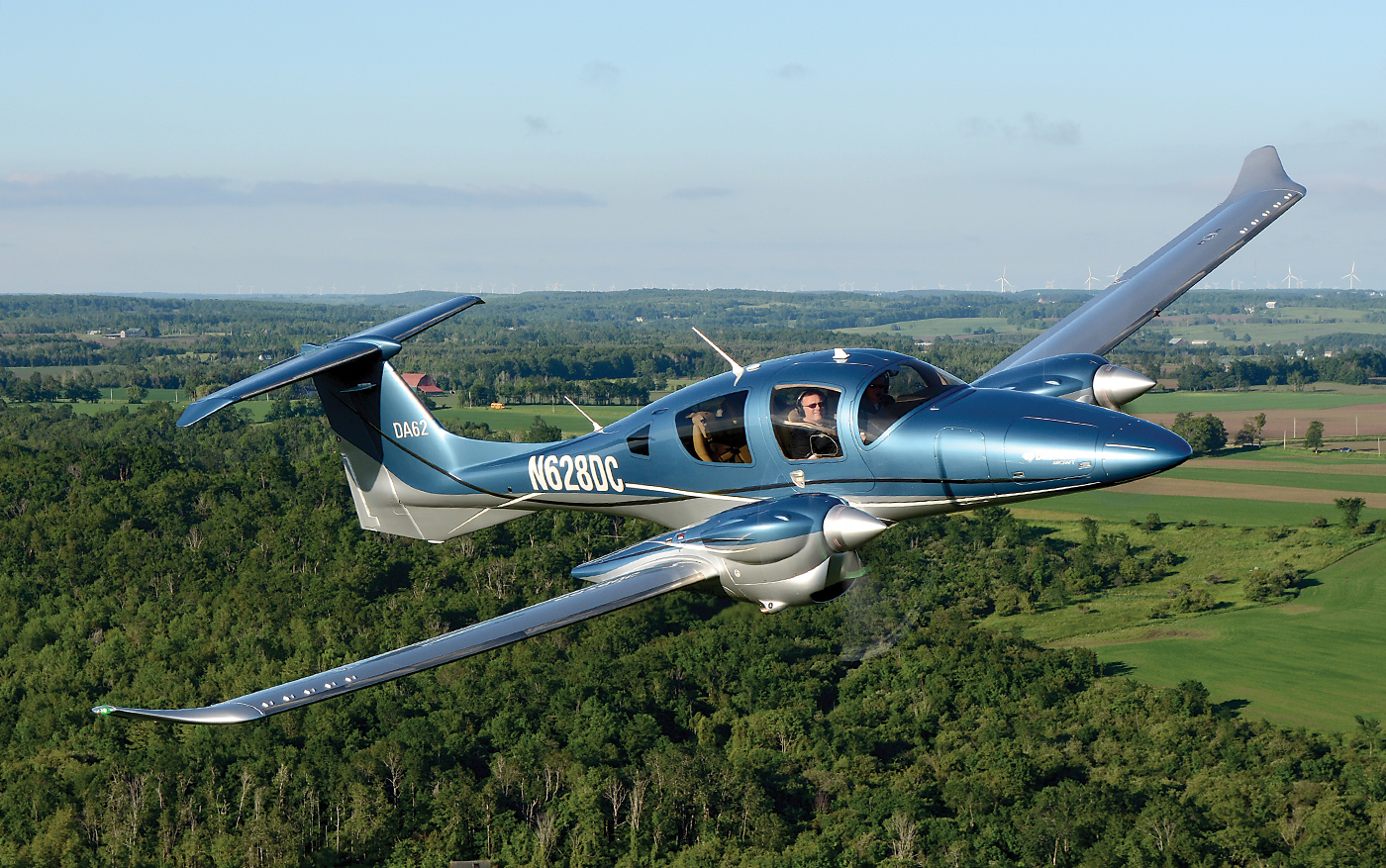Estimated reading time 13 minutes, 29 seconds.
The years haven’t been kind to the light piston twin. Several decades ago, in the heyday of general aviation manufacturing, there were dozens of light piston-powered twin-engine airplanes on the market. Today, there are but a few.
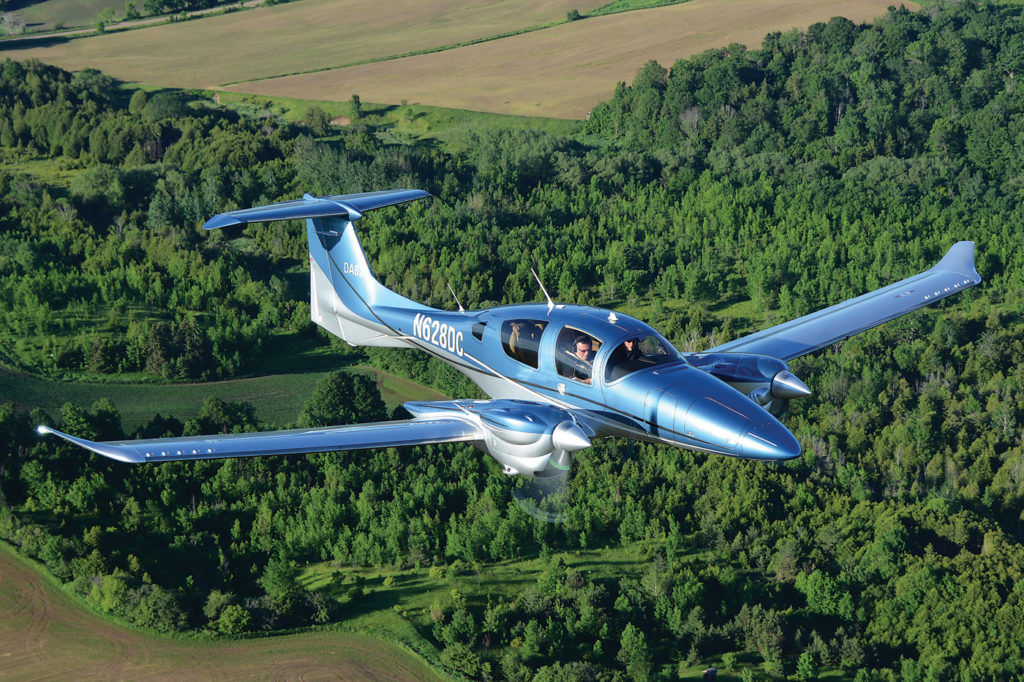
Diamond’s new DA62 may well serve to reverse that trend. Skies magazine was invited to evaluate the innovative composite twin at Diamond Aircraft’s factory in London, Ont. The flight revealed an airplane that combines impressive cruise efficiency with unprecedented simplicity of operation and easy handling.
Anyone seeking to eulogize the light twin will no doubt quote two factors that purportedly led to its demise: fuel economy and safety. There is no question that it is more expensive to feed and service two powerplants, and today’s fuel prices will give anyone pause to think before buying an airplane with an “extra” engine.
Furthermore, the primary attraction of a twin-engine airplane is redundancy in the event of an engine failure; however, accident statistics have conclusively proven that a light twin is no safer than a single-engine airplane after an engine failure. Sure, there’s a second engine, but among the legacy piston twins the complex systems, tricky handling and marginal single-engine performance all erode the presumed safety margins.
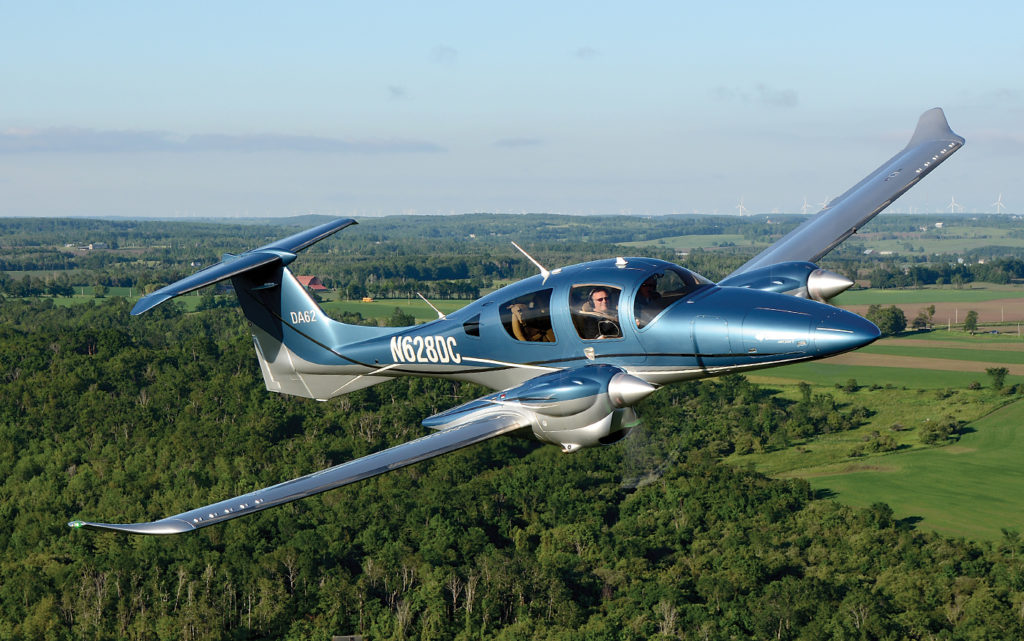
The DA62 shines where legacy twins were weak.
Shiny New Diamond
It’s hard to identify the single coolest thing about the DA62, but its Austro Engine AE330 powerplants must be high on the list. They are liquid-cooled, four-cylinder, four-stroke compression-ignition designs, featuring common rail fuel injection, intercooled turbochargers and gear reduction, producing 180 horsepower.
That’s quite a hyphenated mouthful, but did you notice the “compression ignition” part? Yes, as in “diesel.” Diamond has been an industry leader in the development of jet fuel compression-ignition piston aircraft engines, and from my brief exposure to the DA62 I can understand the appeal. In addition to being smooth and quiet, their electrical engine control units (ECUs) perform digital magic that greatly simplifies engine management. Liquid cooling also eases operation by eliminating the risk of shock cooling. In further happy news, the overhaul interval (TBO) has recently been increased to 1,800 hours.
A notable advantage of the DA62’s novel engines is that they burn Jet A; a big benefit not only because jet fuel is typically cheaper, but because in some locales avgas is simply not available.

The DA62 shares a superficial similarity to Diamond’s other twin, the DA42; however, with seven seats it’s a completely different aircraft. Both cockpit seats are accessed via spacious gull-wing doors, plus a third on the left fuselage for access to the back seats. There is a 60/40 split flat-folding three-seat centre row and an optional third row incorporating two seats. I took a turn climbing into all of the seats, and found the combination of generously sized doors and ample hand-holds made it a breeze. Two forward baggage compartments, accessed via two small gull-wing doors on the nose, had a capacity of 66 pounds per side, simplifying management of the centre of gravity.
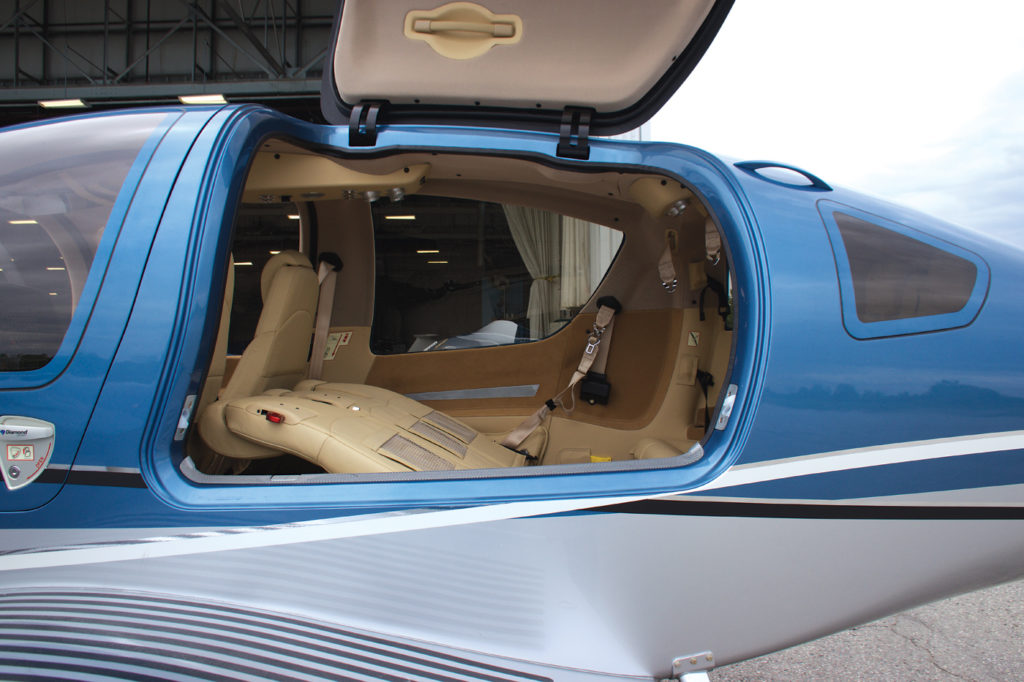
The optional equipment list provides considerable operator flexibility and includes air conditioning, 36-gallon auxiliary fuel tanks, weather radar, satellite datalink for weather and entertainment, and a TKS “weeping wing” anti-icing system certified for flight into known icing (FIKI). An upgrade to the latest Garmin G1000 NXi avionics system will also prove a popular option.
Climb Aboard
It was my privilege to fly the DA62 with Diamond’s chief pilot, Bill Scott. He compared the DA62 to a flying luxury SUV, but I was thinking sports car as I hefted myself up the trailing edge step and then lowered down into the sporty cockpit. The interior layout, gull-wing doors and control sticks in lieu of yokes conspired to whisper “Ferrari.” It’s the sort of airplane that makes you wish someone was taking a picture of you. Once settled, I found the seats comfortable and the field of view outstanding. The backrests and rudder pedals are adjustable.
Starting the DA62 was almost comically simple. Once the electrical master switch was selected on, the G1000 displays were online within about 30 seconds. Following a quick poke at some self-test buttons, the procedure called for the left engine master switch to be selected on, followed by a brief pause until the engine glow annunciator extinguished, after which the starter button was depressed. Vroom! The process was repeated with the other engine, and we were ready to taxi before I found a place to hide my pen.
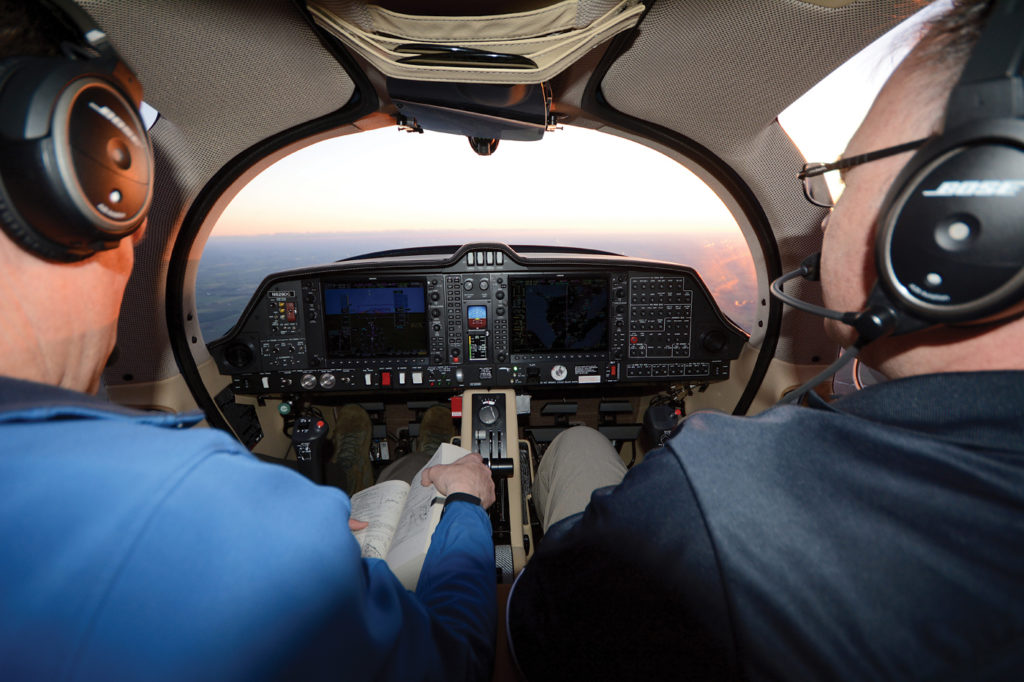
The run-up check was similarly straightforward, after we had taxied for a few minutes to warm up the engine oil, coolant and gearbox temperatures. Run-up literally required two steps: depress the ECU test buttons and wait while the engines underwent a programmed test routine, then momentarily test each of the duplex ECUs with another switch. The absence of engine warning annunciations after the test indicated that we were good to go. The checks can be completed simultaneously, making the warm-up the longest part of the pre-flight routine.
It was a long taxi from Diamond’s factory to the active runway. I found that the pedals required nearly continuous small nudges to deflect a slightly stiff nosewheel steering mechanism, but otherwise taxiing was pleasant. The two engines sounded like distant sewing machines. Under all that glass, I was already in love with the air conditioner.
Our DA62, registration N628DC, serial number 38, had an empty weight of 3,749 pounds. We added two ostensibly adult humans, 66 pounds of gear, and seven gallons of TKS de-icing fluid, bringing our zero fuel weight to 4,257 pounds. Fuel onboard was about two-thirds of maximum capacity of 89 gallons, bringing our gross takeoff weight to 4,718 pounds. Maximum takeoff weight for the North American models is 5,071 pounds, which left an available payload of 360 pounds. From another perspective, our demonstrator aircraft had a very respectable full fuel payload of 717 pounds, notwithstanding that it was carrying a generous list of options.
Smooth Cruising
It was a perfect day for a test flight, with a quartering crosswind of 15 knots, gusting to 20, as we lined up on London’s Runway 15. Full throttle yielded an ECU-regulated 100 per cent power; however, upon advancing the throttles I recall mild confusion because the ample acceleration didn’t seem to be accompanied by enough noise. Among their other virtues, the Austro diesel engines are quiet!
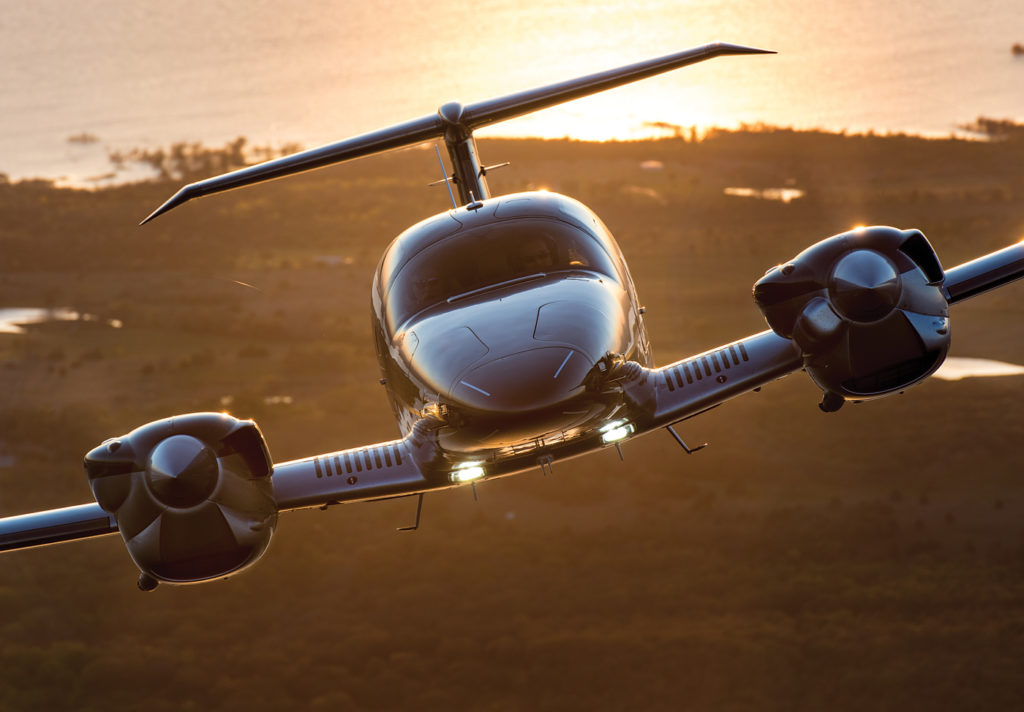
The published takeoff distance at maximum takeoff weight under sea level standard conditions is 1,574 feet with the flaps set to the takeoff position. The DA62 is also approved for operation from unimproved strips.
I used the recommended cruise-climb airspeed of 120 knots indicated airspeed (KIAS), which resulted in slightly better than 1,000 feet per minute climb rate. I selected the Flight Level Change mode and watched the GFC 700 autopilot smoothly climb through mild turbulence with less than a two knot speed variation. Nice.
We levelled off at 10,000 feet (2C air temperature) and 95 per cent power, letting the slippery twin accelerate until we were rewarded with 188 knots true airspeed (KTAS, or 160 KIAS).
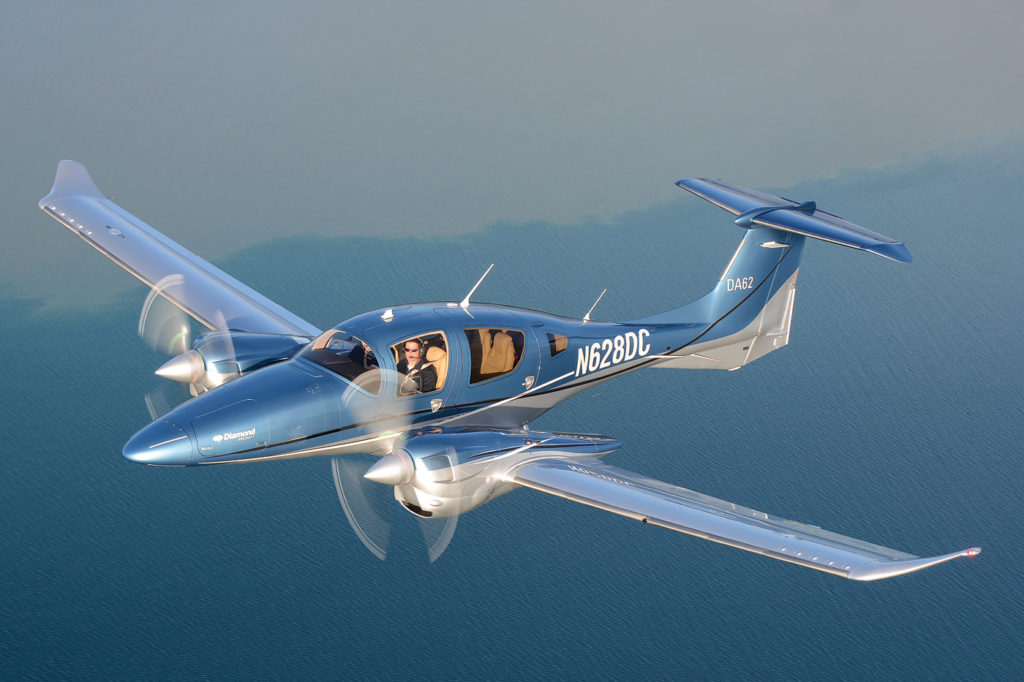
If the reader needs a gentle prod when I reach the punchline, this is it: Our fuel flow was 9.4 gallons per hour of Jet A per engine! I simply cannot imagine another production twin-engine airplane that can approach the DA62’s impressive cruise efficiency.
Higher altitudes or lower power settings offer even more efficient cruising options. The certified ceiling for normal operations is 20,000 feet. For example, at 16,000 feet, standard conditions and realistic operating weights, a 75 per cent power setting yields a published speed of 177 KTAS burning 14.8 gallons per hour. On missions where endurance is the objective, a 50 per cent power setting delivers 144 KTAS and 9.7 gallons per hour. With a published no reserve maximum range of 1,345 nautical miles, or a maximum endurance of 9.5 hours, full fuel tanks in the DA62 broaden one’s options.
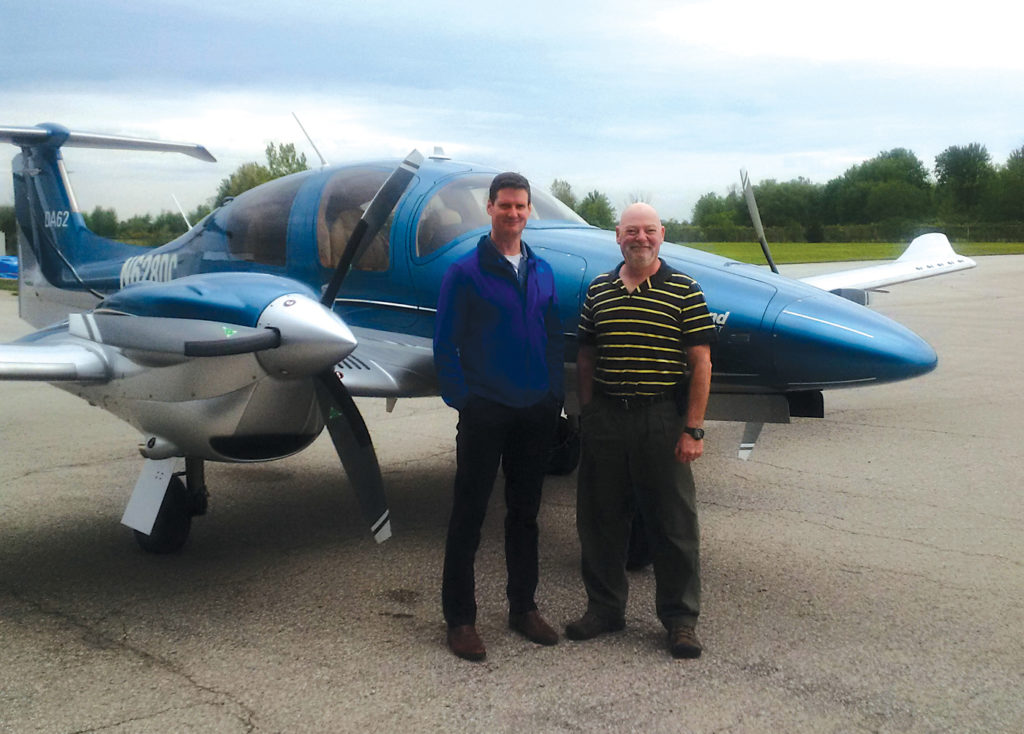
Looking around the DA62’s tidy cockpit, I was struck by what was missing. In lieu of the usual forest of knobs and levers–throttle, propeller speed, mixture, cowl flaps, carburetor heat, magnetos–the DA62’s engine controls consisted of a power lever and an engine master switch. Propeller speeds were set and synchronized by the ECUs. Mixture control was automatic, as was everything else. It was simplicity itself. One can hardly wish for less.
Handling
We found a few minutes to assess the DA62’s handling. I was a big fan of the conventional stick and throttle arrangement, even in a twin, and found the controls all fell comfortably to hand. Control response was pleasant for hand flying, with just a bit of adverse yaw in evidence at low speeds. I found the rudder forces firm.
We did a few power-off stalls in various configurations. They were uniformly benign, with a gradual crescendo of airframe and control buffeting, in addition to the mandatory lights and tones, to awaken even the most obtuse pilots. At our loading condition, I could comfortably sustain full aft stick while retaining adequate lateral control.
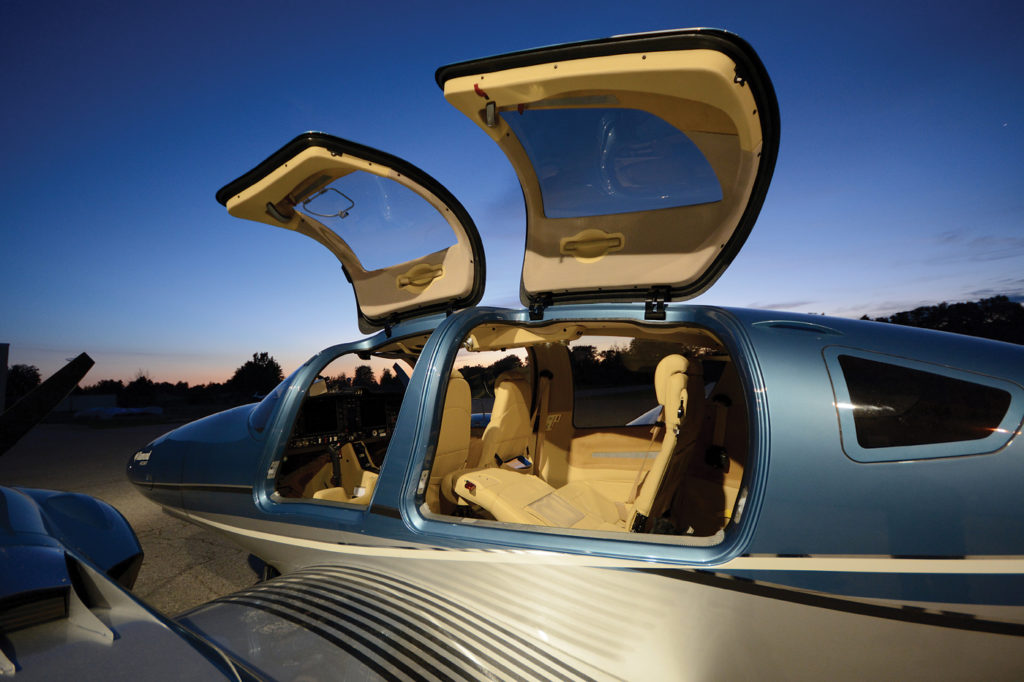
Scott talked me through an engine shut-down. The procedure was as follows: Shut off the switch. Okay. I wanted to simulate a worst-case engine failure on takeoff, so I applied full power with the speed still low following a practice stall in the takeoff configuration. Passing the normal rotation speed of 80 KIAS, I selected the critical left engine master switch off. Faster than I could say, “identify, verify, feather,” the engine shut down and the propeller feathered. The transition to a single-engine climb at the recommended 87 KIAS presented no undue challenges. Again, rudder forces were high, but trim authority was sufficient. The certified single-engine ceiling is 13,000 feet.
En route back to London, Scott made quick work of the set-up for an autopilot coupled instrument approach on the Garmin G1000 avionics suite. I used the opportunity to feign distraction, allowing our roll attitude to increase toward a dangerous spiral divergence. Fortunately, the G1000’s Electronic Stability Protection (ESP) system was paying attention, activating to gently nudge the controls back toward a safer flight regime; an invaluable safety feature in a light airplane.
All too soon, the DA62’s solid trailing link undercarriage lowered us onto the runway at London. It speaks well of an airplane when I need to consciously restrain myself from adding power and taking it around the pattern again. I was smiling. In the DA62, there’s a lot to like.
Utilitarian Efficiency
I foresee the DA62 fitting into myriad missions. Given its jet-like operating simplicity, the DA62 would be an ideal twin-engine trainer for those pilots intent upon flying “grown up” airplanes.
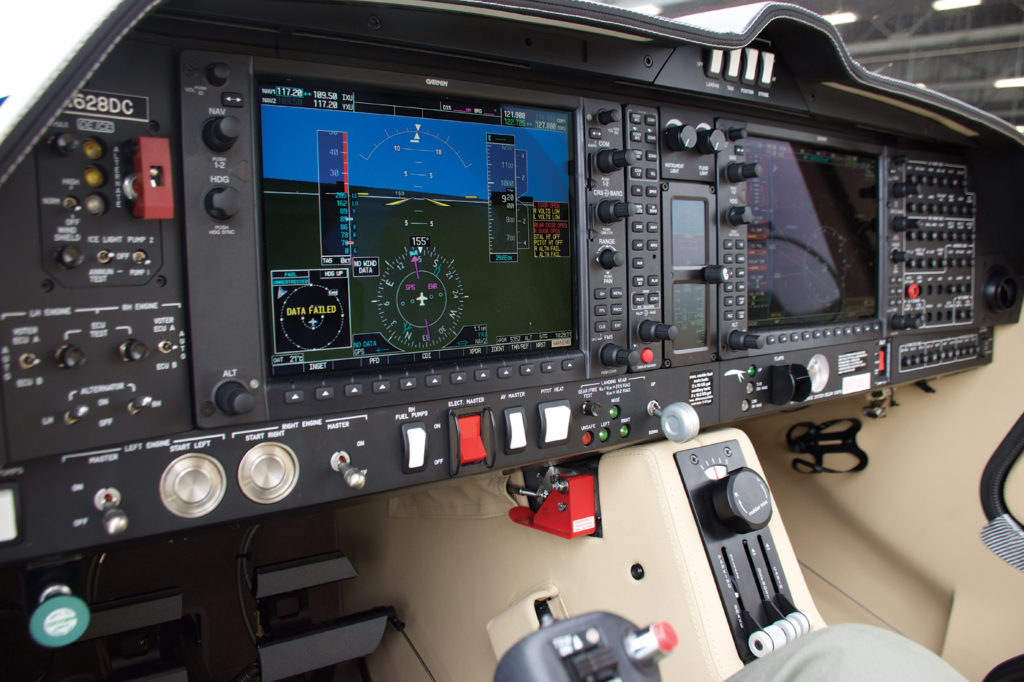
With seven seats, it’s certainly not the cheapest dedicated trainer, but some operators will appreciate an aircraft with legitimate charter capability. It would make an ideal light corporate shuttle, especially for flight departments with mixed fleets where the crews have all but forgotten concepts like cowl flaps and mixture controls, since its operation is “turbine simple.”
It’s easy to envision the DA62 as personal transportation for a family that feels that redundancy is better served by a “spare” engine than a parachute. In short, there are plenty of uses for a DA62. Perhaps there are good reasons to buy a piston twin after all.

Robert Erdos is a contributing editor for Skies magazine. He is a graduate of the U.S. Naval Test Pilot School and a professional test pilot. Also an aviation enthusiast, his spare time activities include displaying vintage airplanes and flying his RV-6 kitplane.
